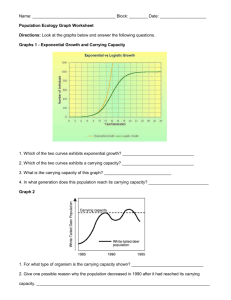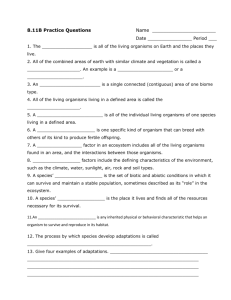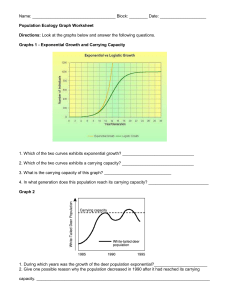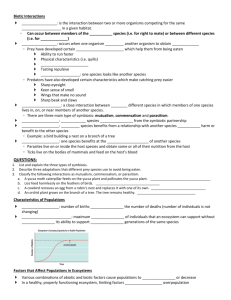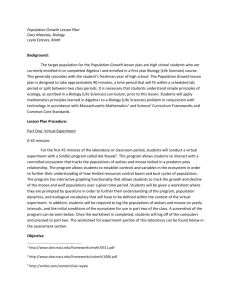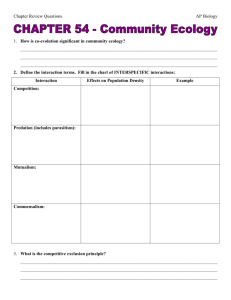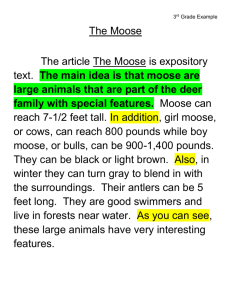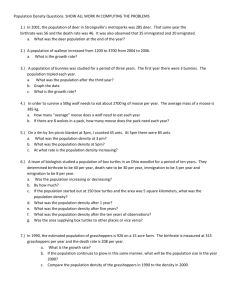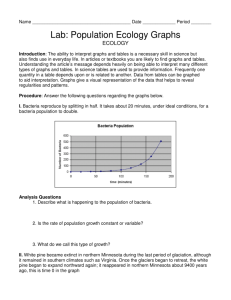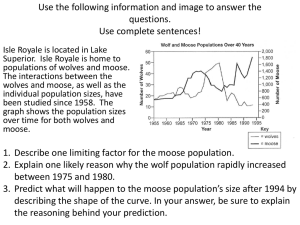Honors Biology Summer Assignment 2015
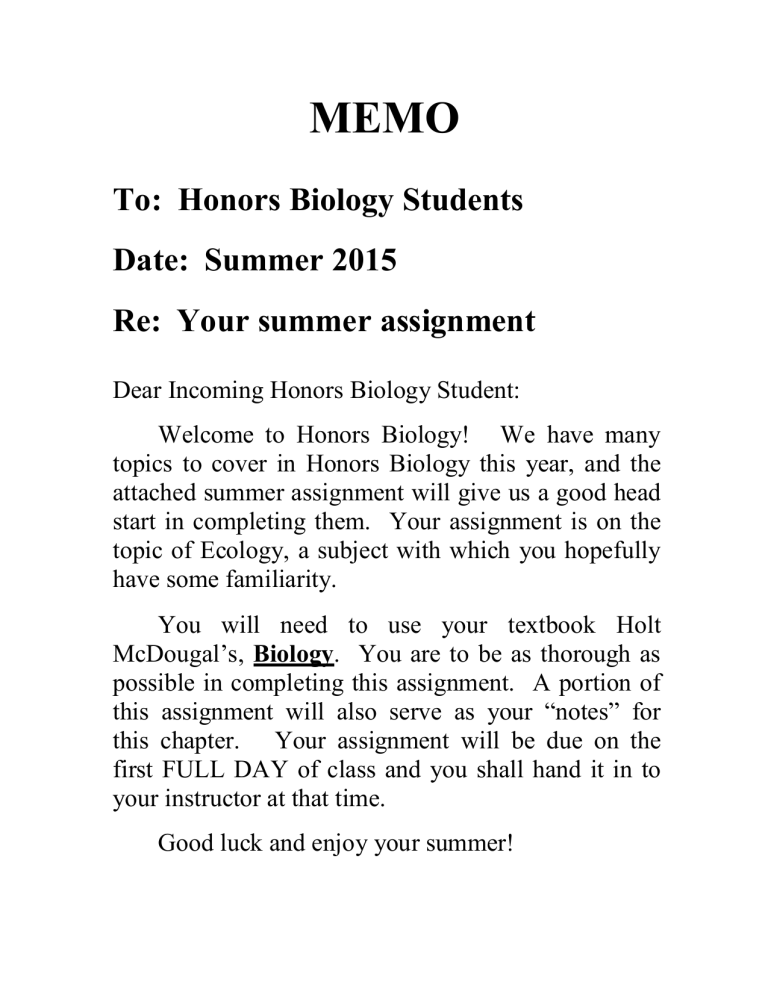
MEMO
To: Honors Biology Students
Date: Summer 2015
Re: Your summer assignment
Dear Incoming Honors Biology Student:
Welcome to Honors Biology! We have many topics to cover in Honors Biology this year, and the attached summer assignment will give us a good head start in completing them. Your assignment is on the topic of Ecology, a subject with which you hopefully have some familiarity.
You will need to use your textbook Holt
McDougal’s, Biology . You are to be as thorough as possible in completing this assignment. A portion of this assignment will also serve as your “notes” for this chapter. Your assignment will be due on the first FULL DAY of class and you shall hand it in to your instructor at that time.
Good luck and enjoy your summer!
COVER PAGE
Honors Biology
Summer Assignment
Name:
Directions: Complete the following pages using your textbook to find the answers to the questions. Write your answers in the spaces provided. Be thorough and write neatly!
SUMMER ASSIGNMENT/NOTES
CHAPTER 13 – PRINCIPLES OF ECOLOGY
Chapter 13.1 – Pages 396-401
Ecologist Study Relationships
What is Ecology?
Define “Ecology”
Levels of Organization.
Define & give an example of the following:
Organism
Population
Community
Ecosystem
Biome
Observation Outline the types of observations that ecologists may make
Experimentation List and describe the benefits and problems with the two types of experiments that ecologists may conduct.
Modeling: describe what is meant by modeling, why modeling is used, and give an example of its use.
Chapter 13.2 – Pages 402-405
Biotic and Abiotic Factors
Biotic Factors (define and list examples)
Abiotic Factors (define and list examples)
Biodiversity (Define and state the areas (s) which have high levels of biodiversity)
Keystone Species (define and explain how beavers are a keystone species)
Chapter 13.3 – Pages 406-407
Energy in Ecosystems
Define and, where appropriate, give examples of of the following:
Producers:
Autotrophs:
◦ auto-
◦
-troph
Consumers:
Heterotrophs:
◦ hetero-
Chemosynthesis and Chemosynthetic organisms
What is the role of photosynthetic organisms in energy capture and transfer?
Chapter 13.4 – Pages 408-411
Food Chains and Food Webs
Food Chain: (define and provide example)
Types of Consumers
Describe and give examples of the following heterotrophs:
Herbivores --
Carnivores --
Omnivores –
Detritovores –
Decomposers –
Specialist –
Generalist –
Define the following terms and give examples, where appropriate, of who they are, what they do or what they eat.
Trophic Levels –
Producers
Primary Consumers
Secondary Consumers
Tertiary Consumers
What is being transferred from Producers up to the different levels of Consumers?
Define a Food Web and compare and contrast it with a food chain.
Draw arrows indicating the flow of energy in this food web:
Chapter 13.5 – Pages 412 – 416
Cycling of Matter
Define, describe, and label the diagrams of the following cycles:
Hydrologic cycle
Biogeochemical cycles
The Oxygen Cycle
Carbon Cycle
Nitrogen Cycle:
Phosphorus Cycle:
Chapter 13.6 – Pages 417 – 419
Pyramid Models
Where do ecosystems get their energy?
Describe the efficiency of energy transfer between trophic levels? How much is lost between levels? Where does the energy go? Describe and label the Energy
Pyramid.
Define Biomass and describe what is going on at each level of a Biomass Pyramid.
Describe, in general terms, the number of individual organisms we typically expect to see in each trophic level.
Intentionally
Blank
CHAPTER 14 INTERACTIONS IN ECOSYSTEMS
Chapter 14.1 pgs 426-430
Habitat and Niche
A habitat differs from a niche.
Define “Habitat”
Define
“Niche” and provide a description of what an organism’s niche includes
Resource availability give structure to a community.
Define and explain “Competitive Exclusion” and the following terms also. o Niche Partitioning o Evolutionary Response
Ecological Equivalents
Define Ecological equivalents and describe an example.
Chapter 14.2 Pgs 431-435
Community Interactions
Competition and predation are two important ways in which organisms interact. o Define “Competition” and give an example. o Define “Predation” and give an example
Symbiosis is a close relationship between species.
Define
“Symbiosis” o Define “Mutualism” and give an example. o Define “Commensalism” and give an example. o Define
“Parasitism” and give an example.
Chapter 14.3 pgs 436-439
Population Density and Distribution
Define
“Population density” o Provide the equation for calculating population density: o Calculate the density of bison if there are 300 bison counted in a 40 square kilometer area. Show you work.
Geographic dispersion of a population shows how individuals in a population are spaced. o Define “Clumped Dispersion” Provide an example and draw an illustration in the box provided. o Define “Uniformed Dispersion” Provide an example and draw an illustration in the box provided. o Define
“Random Dispersion” Provide an example and draw an illustration in the box provided.
Survivorship curves help to describe the reproductive strategy of a species.
Define the
“Survivorship Curve”
In general, what is a reproductive strategy?
Describe each of the following strategies and give an example. Then, graph and label all three in the space provided. o Type I o Type II o Type III
Chapter 14.4 pgs 440-444
Population Growth Patterns
Changes in a population ’s size are determined by immigration, births, emigration and deaths.
Describe some factors that can have an impact on the size of a population (other than the ones listed above):
Define and describe the impact of the following factors: o Immigration o Births o Emigration o Deaths
Population growth is based on available resources.
Define
“exponential growth”. List and describe factors and conditions under which exponential growth occurs. Draw a general graph depicting an exponential growth curve in the space provided,
Define “logistic growth”. List and describe factors and conditions under which logistic growth occurs. Draw a general graph depicting an logistic growth curve in the space provided.
Define
“Carrying Capacity”
Is the carrying capacity in an environment always the same, or can it change?
EXPLAIN.
Define
“Population crash” Describe why one may occur.
Ecological factors limit population growth.
Define the general term “Limiting Factor” o Define, in general what is meant by a
“density-dependent limiting factor”
o Describe how each of the following acts to limit growth in a density dependent way.
Competition
Predation
Parasitism and disease o Define, in general what is meant by a “density-independent limiting factor” o Describe how each of the following acts to limit growth in a density independent way.
Unusual weather
Human Activities
Answer the following questions using the information below :
Isle Royale National Park on a remote island was established in 1940, and designated a wilderness area in
1976. The only mode of transportation available is by boat or seaplane. Moose first arrived at Isle Royale around 1900. The moose population tends to increase in years with mild winters, early spring green-up, abundant winter forage, low wolf numbers and low levels of tick infestation. Wolves first arrived at the island on an ice bridge from Canada in 1940. Disease has also influenced the wolf population. Between 1980 and
1982, the wolf population declined from 50 to 14, due to canine parvovirus.
1. What is the greatest moose population? What year did that occur? What was the wolf population when the moose population the greatest? ______________________________________________________
___________________________________________________________________________________
2. What would happen to the wolf population if the moose population decreases? __________________
___________________________________________________________________________________
3. What would happen to the moose population if the wolves were removed from Isle Royale?
___________________________________________________________________________________
4. Describe the pattern between the wolf (predator) population in relation to the moose (prey) population.
___________________________________________________________________________________
5. Identify a factor, other than moose population, that has influenced the wolf population in Isle Royale.
___________________________________________________________________________________
6. Identify two factors, other than the wolf population, that may influence the moose population.
___________________________________________________________________________________
___________________________________________________________________________________
Chapter 14.5 pgs 445-47
Ecological Succession
Succession occurs following a disturbance in an ecosystem.
Define “succession” o Define “primary succession”. Define “pioneer organisms”.
Set forth the steps of primary succession from beginning to end.
o Define
“secondary succession” and describe the steps. o How are primary and secondary succession similar? How are they different?
